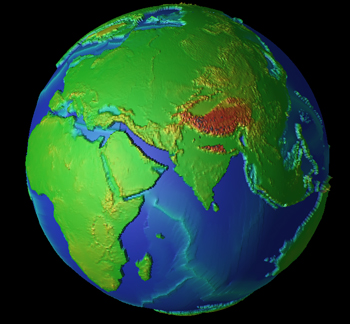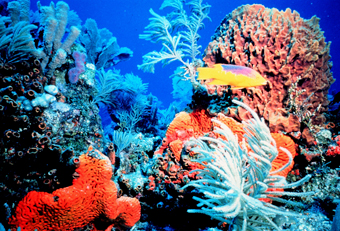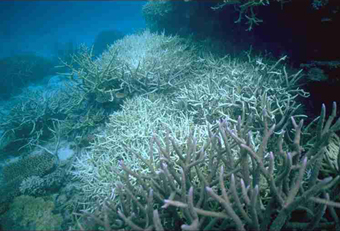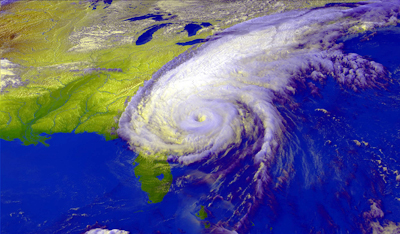Spring 2014
Earth Systems Science
IN THE LAST ISSUE of Spheres, we introduced climate modeler Matt Huber who arrived in September from Purdue University. In part two of the interview, Huber talks specifically about his paleoclimate work concerning two warm-Earth epochs, the large uncertainties inherent in making climate predictions based on general circulation model runs, and the ethical dilemmas involved in communicating uncertain results to the general public.
 |
||
| Changes in ocean heat transport have long been thought of as a logical way to explain the large, high-latitude warmth of past time periods such as the Eocene and Miocene, and changes in the continental configuration of the Earth—as depicted here—is the popular way of explaining increases in ocean heat transport during Earth's history. Read more detail on the enlarged linked image. Image courtesy of Matthew Huber, UNH-EOS. |
||
Spheres: What is the focus of your studies of Earth’s past climate, your paleoclimate modeling work?
Huber: A lot of my paleo work has been on the Eocene epoch about 56 to 34 million years ago. The Eocene was much hotter than today—more than 10 degrees Celsius in terms of global mean temperature. That’s almost 20 degrees Fahrenheit hotter than today. The poles were ice-free. There were crocodiles near the North Pole and large forests going all the way to the north coast of Greenland. And, as far as we know, carbon dioxide was pretty high.
But there is a more recent period in Earth’s history, the Miocene from about 23 to 5.3 million years ago where atmospheric CO2 was in range of today’s or perhaps a little higher—450 parts per million compared to 395 ppm—and that world was something like 10 to 13 degrees Fahrenheit warmer than today. What’s that all about, how did that happen?
There are two reasonable interpretations of the data we have on the Miocene. One is that if you give the Earth system enough time, and if the feedbacks are so large and so positive, adding just a little bit of CO2 causes the Greenland ice sheet and half the Antarctic ice sheet to go away and change vegetation in such a way that more solar radiation is absorbed. This further warms the world and sea level rises, and so on. In other words, a whole set of feedbacks kick in once that threshold is crossed, and a little initial warming due to CO2 leads eventually to a lot of warming.
And, importantly, there may be feedbacks we don't even know about yet. And one reason I think that's the case is because you have to force the models with something like four times more CO2 than was actually there to get the planet to look like it did during the Eocene.
Every piece of work on paleoclimate that's been done suggests the models aren't sensitive enough to CO2, which means we're missing positive feedbacks. If that's true, if the system is really sensitive to CO2, then what we're doing right now is pushing very hard up against that threshold. Some people would say we've already committed to that, but I think that's very much an open question.
CO2 as the go-to guy
Spheres: You said there were two options, what’s the other one?
Huber: One alternative that some people have looked at, which is harder to wrap your head around, is that during some periods in Earth’s history, such as the Miocene, some other factor was driving major warming. In that case, maybe CO2 was higher because the oceans were warmer, and the oceans were warmer for as yet unknown reasons.
 |
|
| Matt Huber Photo by Anne Huber. |
We know when you warm a fluid more CO2 leaves and goes into the atmosphere. Just think of a warm beer going flat. So maybe there was something else that maintained the warmth of the Miocene and it just let CO2 be a little bit higher. In other words, maybe CO2 wasn't driving the system in the Miocene, it was just passively responding and producing a weak positive feedback.
That's kind of a vexing possibility because now you're basically proposing something that sounds like magic; you're saying there's some unknown force that warmed the world. I don't like magical thinking, but it's important to at least carefully study non-CO2 forcing of climates, since it's possible that mysterious factor may have also been partially responsible for Eocene warmth.
So, by relying on CO2 as our go-to guy to solve all problems maybe we're not looking at other clues, and the Miocene is telling us in no uncertain terms that there may be unusual suspects and that we should definitely pay more attention to them. That's because if there are unusual suspects we have to rethink how we're interpreting the past climate record, which may also be important for thinking about the future.
Spheres: How do you go about uncovering these unusual suspects?
Huber: This will be one of the things I work on for the next five to ten years—being open to the possibility that there is some non-CO2 component, some new piece of physics or chemistry operating in time periods like the Miocene. I'll then compare and contrast that with the alternative hypothesis that what's going on in the Miocene is simply a very strong feedback with CO2. I don't know what the answer is going to be, but either way we're going to learn something.
Spheres: It seems surprising that scientists are more or less in the dark about what this mysterious factor is in the Miocene.
Huber: The reality is that almost no one worked on explaining Miocene warmth until about five years ago. There have been prominent papers in Nature and Science discussing what's called decoupling—basically pointing out that there are periods of time in the Miocene and Pliocene where it seemed CO2 was largely decoupled from climate change. However, the problem is we don't have a lot of other tools in our toolbox, so once you say it's not CO2 there's just a lot of hand waving—okay, then it's ocean heat transport, or vegetation albedo feedbacks—plants absorbing or reflecting the sun's energy, for example.
But the models show that ocean heat transport isn't enough to change climate substantially in the Miocene, and when you look at the vegetation feedbacks, those might warm the planet a bit but not by seven degrees Celsius.
Spheres: How does all this mystery impact the "validity" of your work?
Huber: If you do what I do for a living you know the models have large uncertainties and, actually, people like me slave over the uncertainties all day long and grapple with real ethical questions with respect to how you communicate your uncertain findings in a productive way.
That is, if you spend years of your life coming up with a prediction but know your model isn't perfect, know there are large error bars, how do you convey anything meaningful to the average person. I might tell them my model predicts that, in the future, a typical New Hampshire summer will look like today's typical heat wave, which would ordinarily be just one week, and that we derived the model using first principle physics as well as tried validate it against past observations. In other words, I'm saying it's going to be twice as hot as they are used to, but I can't say so with absolute sureness.
People might ask, “What does that mean? Could it be colder?” Yes. The chances are small but I can't rule that out either. And then to that people might state, “So what you're saying is you don't know.” But that's not at all what modelers are saying. We're saying we have a lot of knowledge about the system and have a good deal of predictability in the system, but our predictability isn't perfect.
Looking at it another way, people in finance are well aware they may not be able to predict a particular stock will go up today or tomorrow or exactly how much it'll go up, but they can say that it will probably go up, and they know why. Just because they say "probably" doesn't mean they have no idea. If you don't believe me, ask Warren Buffett.
And people base their entire business models on making predictions about the future with a certain degree of reliability and a certain degree of uncertainty. So it can be very challenging, but it's still very important to try and convey what we mean by "uncertainty" in climate modeling so that the general public understands.
Alarmist, or raising an alarm?
Spheres: Can you elaborate on the ethical issues you mentioned?
Huber: The big ones come up specifically with regards to very fine-scale events. That is, we have a 100-years worth of models, theories, and observations and can say with confidence that each time you double CO2 the planet warms by a couple of degrees. But when we scale it down to a specific region, like southern New Hampshire—which is what people really care about because, frankly, if you say the world as a whole will warm by two degrees that doesn't mean anything to anybody—that's where our error bars get really, really big. So you're left with an ethical dilemma: do I just keep repeating over and over the same things I'm reasonably sure about or talk about very specific predictions in which I have a lower confidence?
Spheres: Can you provide a specific example from your work?
 |
|
 |
|
| Healthy (top) versus bleached coral reefs. Photos courtesy of NOAA. |
Huber: One of my Ph.D. students did his dissertation on coral reef bleaching. Coral reefs are a key component in the global ecosystem and responsible for a large part of the oceans' biodiversity. They're extremely important. We crunched a bunch of numbers and found that most of the coral reef ecosystems will be dead around 2050-70.
That's the sort of thing that, if it's right, and so far other people have found relatively similar results, that really matters to a lot of people. We looked at this again and again and again and triple checked our answers and finally concluded we had it right. We wrote a paper and were very clear about our methods and assumptions so anybody who wanted to could prove us wrong. So, in a case like this, are we being alarmist, or are we simply raising an alarm?
I should add, when you publish a paper, you're never going to know if 50 years from now people are going to say that paper was right, but if you base it in physics, which have been the same since the beginning of the universe, you know it's got something going for it right off the bat.
Spheres: And yet, you mentioned before the need to find a "new piece of physics" in order to explain some of the puzzling mysteries.
Huber: Models are always simplifications of the real world. So when we talk about new physics, we mean physics we left out for the sake of simplicity or because we don't fully understand the processes yet. But sometimes you have to explore new physics, even if you don't understand it 100 percent yet. With this stuff, it can often feel like Hollywood has run out of ideas—that people are just more or less doing whatever they can with the tools they have rather than trying original things. Which is why, about 10 years ago, I started working on how tropical cyclones mix the ocean—something new.
In 2001 there was a paper by hurricane expert Kerry Emanuel of MIT stating that perhaps the missing feedback, the missing piece of physics, was the process of hurricanes mixing the ocean and enhancing ocean heat transport to the poles thereby warming up the world. We know that models don't do hurricanes well.
At this same time, I'd just finished my dissertation—
the conclusion of which said basically either the data for the Eocene we have are all wrong or there's some fundamental part of the climate system that is just not in any model. Then Kerry's paper came out; he had a mechanism, it was plausible, and, crucially, it was not in any model.
This was an example where Hollywood was not out of ideas. When Kerry came up with this it was a new, not just, "Ah well, the model can do this so let's give it a whirl." It was actually one of the few new ideas in the field I'd heard in 20 years.
So in 2001 I started modeling how hurricanes mix the oceanand brought on my first Ph.D. student who worked on that with me for six years. In 2007 we more or less proved that the underlying physical picture Kerry came up with about hurricanes and ocean mixing was correct and published that in Nature.
There's an example of missing physics that will change some of our answers when we run the models. And there are people who think that this hurricane feedback is responsible for the climate of the Pliocene and Miocene, they think the feedback is so strong it may be partially responsible for the big changes in temperature.
Down from the mountaintop
Spheres: You noted in the last issue of Spheres that you thought the days of “pie-in-the-sky” science were done, and yet aren’t fresh ideas, like that above, often borne from that kind of freewheeling thinking?
Huber: Absolutely, and in that context I’d use the term “blue-sky” science. There’s always the need for that, there’s actually quite a lot of room for somebody sitting in a room saying, “I wonder if?” And, frankly, to do that requires not having deliverables and not having end users banging on your door asking ‘Are maple trees going to die next year?’ So there’s a tension there; if you’re going to think big thoughts you have to spend some time sitting on the mountaintop. The days of pie-in-the-sky science aren’t over, it’s just that it can’t be the only type of science we do, climate science is too relevant to the real world.
And actually, my attitude towards being a professor and a teacher and a researcher is exactly that: sometimes you have to withdraw and focus and think really hard, and sometimes that's a slow process and can take years and it can be really hard to explain what you're doing to anybody.
But the latter is absolutely a crucial part of the job—to communicate what you've learned to whoever will listen. That's what being engaged is, from my perspective. I see a lot of similarities between Buddhism and academia, and there's a persistent thread, a worry if you will, that Buddhism can be seen as withdrawing from the world. But there's this concept of engaged Buddhism; sure there are times you need to sit on a mountain and think deeply and have no interruptions for a couple of years, but then you should come down and tell people what you learned. So my view is that academia needs to be engaged as well.
